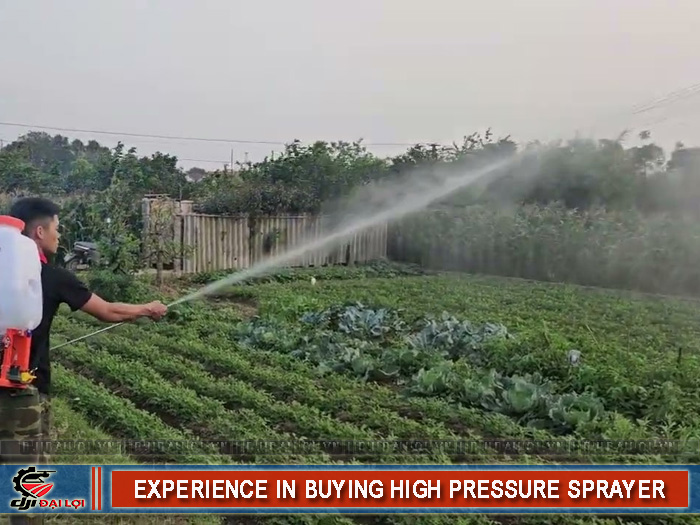
Before choosing a high-pressure pesticide sprayer, evaluate your field size and crop type. For areas under 5,000 m², a 20–25L tank is sufficient. For orchards or farms over 1 hectare, choose a motor over 1.5 kW to ensure long-range, high-pressure, and even coverage.
Tank volume and engine power directly impact spraying performance. A good sprayer should deliver 8–12 L/min at 25–35 bar. For larger areas, a 16–35L tank provides optimal balance between efficiency and fuel savings.
Flat fields work best with trolley sprayers, while sloped or hilly areas require backpack-style sprayers for better mobility and less fatigue.
Equipped with 2-stroke or 4-stroke engines, these offer strong pressure and spray ranges over 12 meters, ideal for large farms or areas without electricity. However, they require routine maintenance of spark plugs, oil, and air filters.
Quiet, eco-friendly, and economical - perfect for small gardens or greenhouses. Their limitation lies in battery life, as most models should not operate continuously for more than 2 hours.
Choosing the right design and durable spray nozzle ensures efficient coverage.
Nozzles determine spray distance and droplet quality. Choose brass or stainless steel adjustable nozzles, and reinforced rubber hoses with steel braids to prevent bursting under high pressure.
A good sprayer should have at least 1.2 kW of power and a stable flow rate for even pesticide distribution. Weak engines reduce pressure, causing uneven spray and lower pest control efficiency.
Select sprayers offering adjustable spray patterns or 10–15 m reach, which can save up to 30% in chemical usage and improve coverage on tall crops.
|
Criteria |
Gasoline sprayer |
Electric sprayer |
|---|---|---|
|
Spraying power |
Strong and stable |
Moderate, quieter |
|
Energy source |
Gasoline 92/95 |
Battery or 220V |
|
Maintenance |
Requires oil, spark plug |
Minimal |
|
Eco-friendliness |
Emits CO₂ |
More eco-friendly |
|
Operating cost |
Higher fuel cost |
Lower electricity cost |
Gasoline sprayers deliver stronger performance for large fields, while electric sprayers suit smaller gardens with quiet, clean operation.
Gasoline sprayers consume about 0.8 L/hour and need more frequent servicing, whereas electric types are cheaper to maintain - only periodic battery replacement every 1–2 years.
For 3–4 hours of continuous work, gasoline models are ideal. Electric sprayers are better for short tasks and nearby areas.
These brands are renowned for durability, strong performance, and easily replaceable parts - top picks for professional farmers.
Local brands cost 20–30% less yet still provide reliable spraying when properly maintained, ideal for small farms.
Check the warranty card and product origin. Choose dealers that offer technical support and after-sales service.
The best time to buy from Đại Lợi is May–July or November–December, when online marketplaces offer 15–25% discounts. Avoid unbranded or counterfeit products.
Many sellers include extra nozzles and pressure hoses, which can save costs and make replacements easier.
Check the spray pressure, nozzle quality, and engine sound. A standard machine should not vibrate excessively or leak solution.
Flush the tank, hose, and nozzle after every spraying session to prevent chemical buildup or clogs - essential for long-term durability.
For gasoline sprayers, replace oil every 50 working hours. For electric models, inspect battery connections and ensure proper charging.
Avoid leaving the sprayer outdoors. Use dust covers to protect the engine and hose from corrosion or moisture damage.
Tall crops like durian or pepper require 30–35 bar, while vegetables only need 20–25 bar to prevent leaf or flower damage.
Wear protective clothing, gloves, and masks. Never spray against the wind or handle chemicals without protection.
Turn off the power, clean the nozzle with water, and check the pump and filter for blockages.
A single high-pressure sprayer can replace 3–4 workers, significantly cutting labor costs.
Strong and even spray ensures better leaf coverage, reducing reinfestation and improving yield.
Sprayers minimize direct chemical exposure and increase spraying efficiency by 200–300% over manual methods.
Beyond traditional sprayers, many cooperatives now adopt crop-spraying drones to automate pesticide application. Drones deliver precise coverage, reduce water use by up to 90%, and eliminate human exposure - a key milestone in Vietnam’s transition to smart agriculture.
In short, choosing the right high-pressure pesticide sprayer isn’t just about price - it’s about reliability, performance, and service support. A wise purchase ensures lasting efficiency and safety for every farming season.
Yes. With fine nozzles and moderate pressure (20–25 bar), they distribute organic sprays evenly without damaging active ingredients.
Absolutely. Adjustable nozzles allow switching between cleaning, watering, or disinfecting modes for farm versatility.
Change oil every 50 hours for gasoline sprayers, or inspect batteries every 3 months for electric models.
Minor issues like nozzle clogging or hose leaks can be fixed at home, but motor or pump problems should be handled by a technician.
No. On the contrary, their powerful, consistent spray pattern reduces pesticide use by up to 30% while improving adhesion to leaves.